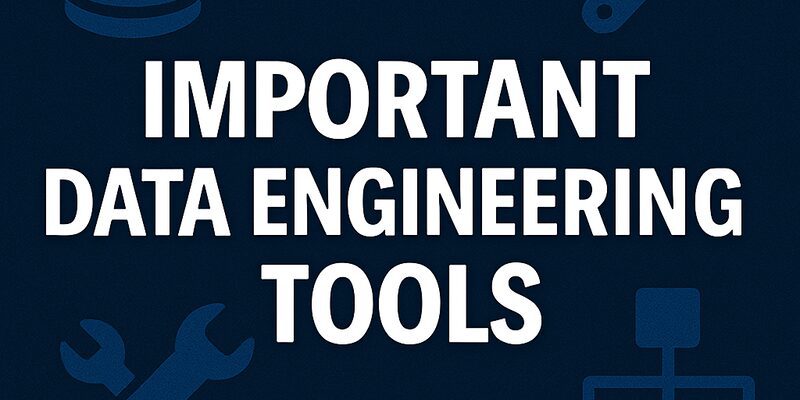The Most Important Data Engineering Tools to Consider for 2026


Solutions Review Executive Editor Tim King Highlights the most important data engineering tools to consider when evaluating commercial solutions.
Data engineering has emerged as the backbone of modern enterprise analytics. While data science often captures headlines with artificial intelligence and machine learning breakthroughs, none of it is possible without the disciplined work of data engineering. Enterprises today are inundated with massive volumes of structured and unstructured data flowing in from applications, devices, transactions, and digital interactions. The ability to ingest, clean, transform, and deliver that data reliably to downstream systems is what makes analytics actionable. In other words, data engineering is the invisible infrastructure that turns raw information into trusted business intelligence.
The complexity of enterprise data environments makes the choice of tools especially critical. With cloud adoption, hybrid architectures, and real-time data demands becoming the norm, enterprises need solutions that go far beyond batch pipelines and manual integration. Data engineering platforms must provide scalability, automation, and resilience at levels that can support mission-critical workloads. Governance, lineage tracking, and compliance are non-negotiable requirements in heavily regulated industries. Equally important is seamless integration with data warehouses, data lakes, and emerging lakehouse architectures, as well as compatibility with modern analytics and machine learning workflows. Without the right data engineering foundation, even the most advanced data science initiatives will falter.
This article identifies the most important data engineering tools for enterprises — commercial platforms designed to operate at scale and trusted by organizations across industries. These solutions stand out for their ability to handle the full lifecycle of enterprise data: ingestion from diverse sources, transformation into usable formats, orchestration of complex workflows, and delivery to analytics environments. They are the tools that empower data teams to build reliable pipelines, ensure data quality, and enable real-time intelligence across the business. For CIOs, data leaders, and architects, understanding which platforms are most impactful is essential to creating a modern data stack that can support both today’s needs and tomorrow’s innovation. By surfacing the commercial tools that matter most, this guide provides a clear roadmap for navigating a crowded market and investing in the technologies that form the true foundation of enterprise analytics.
Note: The best data engineering tools are listed in alphabetical order.
The Most Important Data Engineering Tools
Amazon Web Services
Platform: Amazon Redshift
Description: Amazon Redshift is a fully-managed cloud data warehouse that lets customers scale up from a few hundred gigabytes to a petabyte or more. The solution enables users to upload any data set and perform data analysis queries. Regardless of the size of the data set, Redshift offers fast query performance using familiar SQL-based tools and business intelligence applications. AWS also has multiple ways to do cluster management depending on user skill level.
Cloudera
Description: Cloudera provides a data storage and processing platform based on the Apache Hadoop ecosystem, as well as a proprietary system and data management tools for design, deployment, operations, and production management. Cloudera acquired Hortonworks in October 2018. It followed that up with a buy of San Mateo-based big data analytics provider Arcadia Data last September. Cloudera’s new integrated data management product (Cloudera Data Platform) enables analytics across hybrid and multi-cloud.
Fivetran
Platform: Fivetran
Description: Fivetran is an automated data integration platform that delivers ready-to-use connectors, transformations and analytics templates that adapt as schemas and APIs change. The product can sync data from cloud applications, databases, and event logs. Integrations are built for analysts who need data centralized but don’t want to spend time maintaining their own pipelines or ETL systems. Fivetran is easy to deploy, scalable, and offers some of the best security features of any provider in the space.
Google Cloud
Platform: Google BigQuery
Description: Google offers a fully-managed enterprise data warehouse for analytics via its BigQuery product. The solution is serverless and enables organizations to analyze any data by creating a logical data warehouse over managed, columnar storage, and data from object storage and spreadsheets. BigQuery captures data in real-time using a streaming ingestion feature, and it’s built atop the Google Cloud Platform. The product also provides users the ability to share insights via datasets, queries, spreadsheets and reports.
Looker
Platform: Looker
Related products: Powered by Looker
Description: Looker offers a BI and data analytics platform that is built on LookML, the company’s proprietary modeling language. The product’s application for web analytics touts filtering and drilling capabilities, enabling users to dig into row-level details at will. Embedded analytics in Powered by Looker utilizes modern databases and an agile modeling layer that allows users to define data and control access. Organizations can use Looker’s full RESTful API or the schedule feature to deliver reports by email or webhook.
Microsoft
Platform: Power BI
Related products: Power BI Desktop, Power BI Report Server
Description: Microsoft is a major player in enterprise BI and analytics. The company’s flagship platform, Power BI, is cloud-based and delivered on the Azure Cloud. On-prem capabilities also exist for individual users or when power users are authoring complex data mashups using in-house data sources. Power BI is unique because it enables users to do data preparation, data discovery, and dashboards with the same design tool. The platform integrates with Excel and Office 365, and has a very active user community that extends the tool’s capabilities.
Mongo DB
Platform: Mongo DB Atlas
Description: MongoDB is a cross-platform document-oriented database. It is classified as a NoSQL database program and uses JSON-like documents with schema. The software is developed by MongoDB and licensed under the Server Side Public License. Key features include ad hoc queries, indexing, and real-time aggregation, as well as a document model that maps to the objects in your application code. MongoDB provides drivers for more than 10 languages, and the community has built dozens more.
https://www.youtube.com/watch?v=xrc7dIO_tXk
Segment
Platform: Segment
Description: Segment offers a customer data platform (CDP) that collects user events from we band mobile apps and provides a complete data toolkit to the organization. The product is available in three iterations, depending on the user persona (Segment for Marketing Teams, Product Teams or Engineering Teams). Segment works by letting you standardize data collection, unify user records, and route customer data into any system where it’s needed. The solution also touts more than 300 integrations.
Snowflake
Platform: Snowflake Cloud Data Platform
Description: Snowflake offers a cloud data warehouse built atop Amazon Web Services. The solution loads and optimizes data from virtually any source, both structured and unstructured, including JSON, Avro, and XML. Snowflake features broad support for standard SQL, and users can do updates, deletes, analytical functions, transactions, and complex joins as a result. The tool requires zero management and no infrastructure. The columnar database engine uses advanced optimizations to crunch data, process reports, and run analytics.
Tableau Software
Platform: Tableau Desktop
Related products: Tableau Prep, Tableau Server, Tableau Online, Tableau Data Management
Description: Tableau offers an expansive visual BI and analytics platform, and is widely regarded as the major player in the marketplace. The company’s analytic software portfolio is available through three main channels: Tableau Desktop, Tableau Server, and Tableau Online. Tableau connects to hundreds of data sources and is available on-prem or in the cloud. The vendor also offers embedded analytics capabilities, and users can visualize and share data with Tableau Public.
https://www.youtube.com/watch?v=gAruNQGxYMA




























